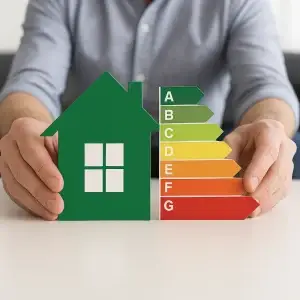Understanding Your Airtightness Test Documentation: A Comprehensive Guide
In the modern construction landscape, the importance of building airtightness cannot be overstated. It directly influences energy efficiency, comfort, and performance in both residential and commercial buildings. After conducting an airtightness test, the documentation you receive becomes an invaluable tool. It not only verifies the air tightness of your building envelope but also provides critical insights into potential improvements. Let’s delve into the typical documentation you can expect after an airtightness test and what it means for your project.
The Airtightness Test Report
At the heart of the documentation is the comprehensive test report. This document is your guide to understanding the outcome of the test, what it signifies, and where improvements might be needed. Let’s break down the key components of this report:
Test Methodology
You wouldn’t be alone in wanting to understand the testing method adopted for your project. Whether it’s the Blower Door Test or the Pulse Air Permeability Measurement System, each methodology serves a distinct purpose. Embedding standards like the AS/NZS ISO 9972:2015, ASTM E779, or ATTMA TSL1 or TSL2, gives you assurance in the accuracy and reliability of the test results. Ratio Seven uses these standardised methods for consistent and dependable outcomes.
Test Results
The results of the test are usually displayed in terms of air leakage rates, which are vital metrics in assessing the building envelope’s efficiency. These rates are often expressed in:
- Air Permeability: Measured as m³/hr/m² at a specific pressure (often 50 Pa).
- Normalised Air Leakage Rates: Expressed as L/s/m² or cfm/ft², these figures help you understand the building’s leakage relative to its size.
Pressure Differences and Airflow Rates
Understanding how pressure differences affect airflow rates is crucial. Your report will typically illustrate this relationship through detailed plots, enabling you to get a comprehensive view of how your building performs under various conditions. The skill involved in measuring and representing this data makes it indispensable in the decision-making process for any necessary retrofit or improvement work.
Essential Airtightness Metrics: What They Mean
Metrics form the backbone of your airtightness assessment. They provide quantifiable data that helps in making informed improvements. Two key metrics stand out:
- Normalised Air Leakage Rate (NLR): This metric provides the airflow rate at a set pressure difference, which is then adjusted by the building envelope’s area. It’s a direct indicator of how ‘tight’ or ‘leaky’ a building is.
- Equivalent Leakage Area (ELA): Representing the total area of all the gaps and cracks in your building envelope, ELA helps benchmark your building’s performance against industry standards.
Building Preparation and Testing Conditions: Ensuring Accuracy
A vital section of your report will detail how your building was prepared for the test, as this affects the accuracy of the results. Here’s what it includes:
- Closure of External Windows and Doors: To ensure accuracy, all external openings must be properly closed and latched.
- Opening of Internal Doors: Keeping internal doors open during the test is crucial for achieving a holistic assessment of the building’s air tightness.
- Sealing of Ventilation Openings: It involves temporarily sealing mechanical and natural ventilation systems to isolate the building envelope for testing.
Identifying Leakage Locations: Targeting Remedial Actions
In some tests, especially those adhering to standards like PAS 2035, reports may highlight key leakage locations. By identifying these areas, you can focus remedial efforts effectively, potentially reducing costs and improving outcomes. The pinpointing of these locations is essential for targeted interventions, enhancing the building’s overall performance while maintaining cost efficiency.

Recommendations and Compliance: Taking Action Post-Test
Once testing concludes, the documentation will provide guidance on possible improvements and compliance status, outlining crucial next steps:
- Ventilation System Recommendations: Based on your air tightness results, the report may suggest the suitability of systems like Mechanical Ventilation with Heat Recovery (MVHR) or Mechanical Extract Ventilation (MEV).
- Compliance with Standards: This includes verification of whether the building meets its specified airtightness targets and adheres to relevant building codes. It’s crucial for ensuring your building meets regulatory and performance benchmarks.
Additional Documentation to Anticipate
Beyond the primary report, you might receive supplementary documents that further support the airtightness agenda:
- Design Submission Template: Particularly relevant for projects that are part of innovation challenges, this template outlines how your project achieved the required airtightness levels and can offer insights for future developments.
- Contractor’s Requirements: Extracts from the main contractual documentation detailing the contractor’s obligations in carrying out comprehensive airtightness testing and meeting specified targets.
FAQs on Airtightness Test Documentation
1. What is the significance of the Normalised Air Leakage Rate and Equivalent Leakage Area?
The Normalised Air Leakage Rate helps quantify the airflow rate at a given pressure difference, standardised for the building’s surface area. This allows for a direct comparison across different sizes and types of buildings. The Equivalent Leakage Area, on the other hand, translates the intangible gaps and cracks into a measurable area, offering an intuitive understanding of the building’s sealed performance against industry benchmarks.
2. How does the test documentation influence building improvements and compliance with standards?
Test documentation serves as a roadmap for identifying where a building falls short in terms of airtightness and energy efficiency. It not only helps in making informed decisions about which areas of the building require focus for improvements but also verifies compliance with important regulations and standards, ensuring the building meets or exceeds required airtightness thresholds.
3. What role do specific test methodologies like the Blower Door Test play in the accuracy of the results?
The choice of test methodology impacts the reliability and validity of test results. Methods like the Blower Door Test provide detailed insights into the pressure behaviour and air leakage of a building. This level of detail ensures any improvements are rooted in precise data, allowing for effective enhancements in both building performance and comfort.
Air Test Certificate & Documents
Upon receiving the documentation post-airtightness test, you’re equipped with detailed insights that guide you in enhancing the air tightness and overall energy efficiency of your structure. Ratio Seven provides not only the testing but a partnership in pursuing optimal building performance. This comprehensive documentation verifies current conditions and illuminates paths to sustainable and efficient construction, ensuring peace of mind and regulatory compliance. Whether you are a homeowner, builder, or property developer, understanding and utilising these documents effectively positions you for long-term success in building performance and standards compliance.




